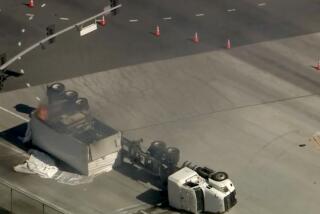Ship Bumps Bridge, but Port Officials Worry More About Truck Traffic
Los Angeles port officials said Monday that a ship collided with the Vincent Thomas Bridge over the weekend because an onboard crane was left extended -- not because the bridge was too low. They said they were more concerned about the potential for problems as truck traffic on the bridge increases.
Port officials said they are preparing to launch a $2-million study of whether the regionâs longest suspension bridge can handle the substantial increase in traffic expected as imports from Asia continue to swell.
They said they thought the bridge might need to be expanded or that a second bridge might need to be built to handle the traffic.
Without expanded bridge capacity, traffic on the bridge will reach gridlock by 2030, port engineers said.
They were quick to add that future improvements would not endanger the current bridge, a popular icon in the harbor area.
âNobody is thinking that weâre going to rip out that bridge and put another bridge in its place,â said Tony Gioiello, the portâs chief harbor engineer. He said the most likely scenario would involve construction of a second bridge next to the existing one or even a bridge in another part of the port.
Port planners typically start work on such projects 25 years before they are needed because of their massive scale and expense, officials said.
The 43-year-old bridge made news Sunday night when the underside of its central span -- the area between its two towers -- was struck by a crane aboard the bulk carrier Beautiful Queen. The ship is owned by Beautiful Queen Shipping Co. Ltd., a subsidiary of Fleet Management Corp., based in Hong Kong, said port spokesman Arley M. Baker.
The ship had left the Pasha terminal at the port and was heading under the bridge and out the main channel for mooring, port and Coast Guard officials said.
The ship was moving to make room for another vessel, a port spokesman said.
The ship remained moored offshore Monday as Coast Guard investigators attempted to piece together the cause of the accident, which marked the first time in at least five years that a ship or ship crane has struck the 6,060-foot-long bridge, the fourth-largest suspension bridge in the state.
The three longest are the Golden Gate Bridge, the western span of the Bay Bridge and Alfred Zampa Memorial Bridge, all in the Bay Area.
The investigation could take days, weeks or longer, said Coast Guard Lt. P.J. Jacquelin, a public affairs officer, who confirmed that the crane was erect when the accident occurred.
If the crane had been stowed, it would not have hit the bridge, he said. âIt made it under the bridge the first time when it came into the port,â Jacquelin said.
At 4:50 p.m. Sunday, the Coast Guard received reports that a vessel had struck the bridge, and that the bridgeâs roadbed was swinging back and forth.
It ordered a halt to vehicle traffic on the bridge and ship traffic below on the main channel.
âYou get a ship striking a bridge, and you donât know what the possibilities are,â Jacquelin said. He said he watched as the ship with its crippled crane moved out of the channel to anchor offshore.
The bridge reopened to traffic at 6:58 p.m. Sunday. A Coast Guard team boarded the ship Sunday night and returned Monday.
The crane damaged a 20- to 40-foot section of the lower portion of the bridge between its two towers, said Caltrans spokesman Dave White. It hit a steel rail used by a traveling work platform that carries painters and other bridge workers back and forth along the span.
The damage had no effect on bridge operations, and Caltrans crews were assessing the damage, White said.
The underside of the bridge at its highest point is 185 feet above the water at low tide. By contrast, clearance at the Golden Gate Bridge is 220 feet.
Many ships entering the Port of Los Angeles are larger than those entering San Francisco Bay, but port officials said Monday that 185 feet is high enough for even the largest container and other cargo ships.
It is not high enough, however, for the mammoth new passenger liners such as the Queen Mary II, which had to do an elaborate pivot when it visited the port for the first time in February.
The bridgeâs limited width, however, is its Achilles heel when it comes to vehicle traffic, port officials say.
A popular route for both trucks and commuters traveling between the Palos Verdes Peninsula and Long Beach, the four-lane bridge already becomes congested during morning and afternoon peak times. About 39,000 cars and trucks cross the bridge daily.
With business at the port projected to triple by 2020, planners anticipate that thousands more trucks will flood the bridge each afternoon, causing standstills in westbound lanes by 2030. That projection assumes that the over-burdened 710 Freeway will receive some improvements in the interim.
So far, $1.6 million in federal money has been approved for the traffic study.
The remainder will be paid for by the port. Port planners are preparing a request for proposals from consultants and hope to have a completed study in 2 1/2 years.
*
(BEGIN TEXT OF INFOBOX)
Californiaâs tallest suspension bridges* (in feet):
Golden Gate--220 ft.
San Francisco Bay--214 ft.
Vincent Thomas--185 ft.
--
*Measured from water at low tide to the underside of the roadbed at its highest point.
Source: Caltrans
(END TEXT OF INFOBOX)
More to Read
Sign up for Essential California
The most important California stories and recommendations in your inbox every morning.
You may occasionally receive promotional content from the Los Angeles Times.










